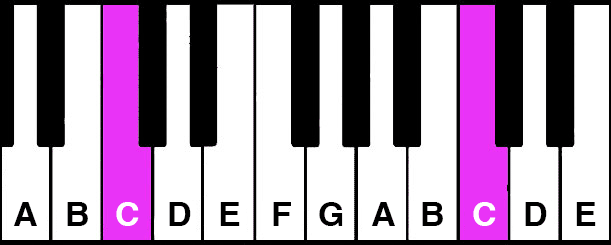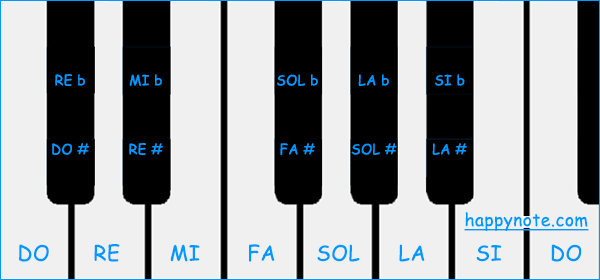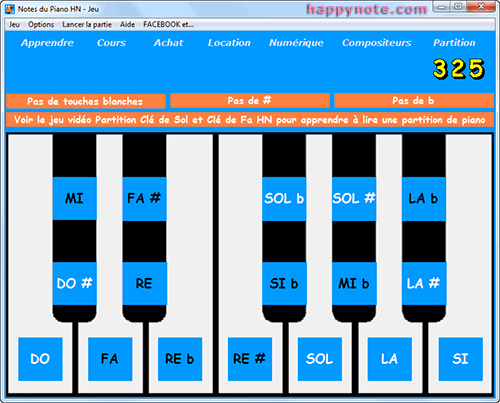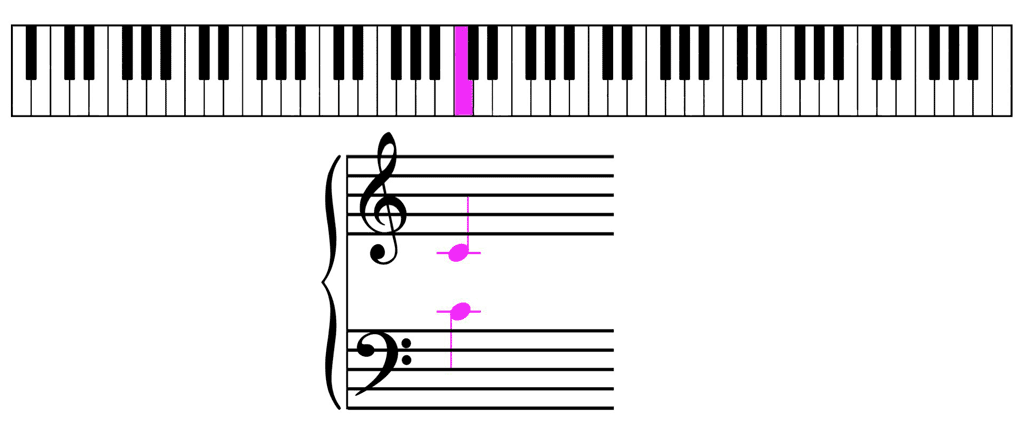If you’re new to music, you probably use the term ‘piano notes’ when you’re actually referring to the black and white piano keys on the keyboard.
Keys or notes? By the time you finish this page, you’ll understand everything you need to start learning piano—and even how to read piano notes if you want!
Can you name the famous classical piece in 10 seconds? Test your skills with these piano notes!
88 Keys: 52 White and 36 Black
Whether it’s acoustic, digital, upright, or a grand, the modern piano has a keyboard with 52 white keys and 36 black keys, allowing you to play 88 notes.
But don’t worry: you only need to learn 12 keys to know them all!
That’s because Western music uses only twelve different tones that repeat in the same order across the entire keyboard at different pitches—getting progressively lower or higher.
The distance between two notes with the same name but a different pitch is called an octave. An 88-key piano has 7 and 1/4 octaves.
The White Keys: C, D, E, F, G, A, B—The 7 Natural Notes
The white keys correspond to the natural notes, meaning those that don’t use sharps or flats.
The first thing to do is find the white key that plays the note C. Luckily, the black keys will help us do just that.
C is always the white key located just to the left of each group of two black keys:

Once you know where the C key is on the keyboard, it’s easy to find the other notes: they follow each other in the order of the C scale:

You should memorize and be able to say the C scale without hesitation, going up the keyboard from low to high (left to right):
C D E F G A B C
It’s also recommended to know it going down, from high to low (right to left):
C B A G F E D C
At first, you’ll use C to find the other notes, but you’ll quickly learn the positions of all seven white keys on the keyboard.

The Black Keys: Whole Steps and Half Steps
The whole step and half step are musical units used to measure the distance between two adjacent notes.
Some adjacent white keys are separated by a whole step, while others are only a half step apart:
- 1 black key between 2 white keys = the 2 notes are a whole step apart.
- 0 black keys between 2 white keys = the 2 notes are a half step apart.

- The adjacent notes C and D, D and E, F and G, G and A, and A and B are separated by a whole step.
- The adjacent notes E and F, and B and C are separated by a half step.
Sharps, Flats, and the Black Keys
On sheet music, the sharp (♯) and flat (♭) are musical symbols called accidentals that change the pitch of the notes they precede:
- The sharp raises a note by a half step.
- The flat lowers a note by a half step.
The black keys allow you to divide whole steps into two half steps using sharps and flats:

Each black key can play two notes: the sharp of the key to its left and the flat of the key to its right.
So, to play the key for a note’s sharp or flat, just find the white key for that note: the black key to its right is the sharp, and the one to its left is the flat.
On some early harpsichords or fortepianos, the key colors were inverted compared to the modern piano: the natural notes were black and the altered notes (sharps/flats) were white. This was a choice related to the use of precious materials like ebony and to the aesthetic preferences of the Baroque era.
The Chromatic Scale: Alternating Black and White Keys
No matter what note you start on, if you play 12 adjacent notes in a row by alternating between white and black keys, you are playing a chromatic scale, which is made up of twelve equal half-step intervals.

Liszt’s “Grand Galop Chromatique” is a virtuosic piece built on the chromatic scale.
Ideal for impressing your friends! (Pianist: Georges Cziffra)
The Pentatonic Scale: Black Keys and a Chinese Vibe
“Pentatonic” comes from the Greek word pente, meaning five. The five black keys on the piano correspond to the five notes used in traditional Chinese music. If you want to create an Eastern-sounding melody, you can improvise using only the black keys.
The Inevitable Question
“Are C♯ and D♭, or F♯ and G♭, the same note?”
In music theory, not exactly — we’re talking about enharmonic equivalence.
In practice:
YES!
Musical Break: 1 Minute and 34 Seconds of Black Keys!
Pianist Vladimir Horowitz plays Frédéric Chopin’s Etude, “The Black Keys“
Why Are the White and Black Keys Reversed on Harpsichords?
On many Baroque harpsichords, the natural keys (C, D, E, F, G, A, B) were dark, often made of ebony or stained wood, while the accidentals were light, covered with bone, ivory, or boxwood.
This reversal, compared to the modern piano, does not come from a single, universally accepted explanation but from a combination of factors.
Rameau’s Les Sauvages on a harpsichord with natural notes on black keys and altered notes on white keys.
Materials played a role: the long natural keys, used most frequently, were built from strong, readily available wood, while the smaller accidentals could be decorated with more precious materials without excessive cost. Aesthetic preferences were also important, as this dark/light contrast was considered elegant and refined by instrument makers and musicians of the time.
This layout also reflects historical continuity. Medieval organs often featured this inverted color scheme, which the harpsichord inherited.
When the piano rose to prominence in the 18th and 19th centuries, the convention gradually shifted: natural keys became white and accidentals black. The change was probably driven by the desire for a brighter-looking keyboard in candlelit concert halls, but also by new aesthetic preferences and a need to distinguish the piano visually from the harpsichord and clavichord.
In this way, the piano established itself as a distinct instrument with its own visual identity.
HN Piano Notes
A free downloadable game for Windows to learn the notes and keys of the piano while having fun!

White Keys and Black Keys, Sharps and Flats
You can choose which piano notes to play with. Just the white keys. Or just the black keys (sharps, flats, or both). Or both the black and white keys together.
Hi-Score
A Hi-Score board and a piano song reward the top ten players!
Virtual Piano
You can also use HN Piano Notes as a virtual piano keyboard. Just click on each white or black key to play a tune!
Reading Notes on Piano Sheet Music
To write piano sheet music, we use two musical staves joined by a brace. The top staff, for the right hand, is usually in the treble clef, while the bottom staff, for the left hand, is in the bass clef.

Happy Note! offers videos to help you learn how to read the piano notes used by the right and left hands. For each note learned in treble and bass clefs, the video highlights the corresponding key on the keyboard.
Right Hand and Treble Clef
The Treble clef is used to write middle- to high-pitched notes played by the right hand.
The following video explains the Treble clef before teaching you to read your first two notes: G and C.
Choose between A B C D E F G or the solfege system Do Re Mi Fa Sol La Si to access all right-hand videos in the Treble clef.
Left Hand and Bass Clef
The Bass clef is used to write middle- to low-pitched notes played by the left hand.
The following video explains the Bass clef before teaching you to read your first two notes: F and C.
Choose between A B C D E F G or the solfege system Do Re Mi Fa Sol La Si. to access all left-hand videos in the Bass clef.
Right Hand and Left Hand: Not Always So Simple
If both hands need to play in the high register, both staves on the piano score will be written in the treble clef.
Similarly, if both hands need to play in the low register, both staves will be written in the bass clef.
It’s also common for the hands to cross over on the keyboard. In that case, the right hand might play low notes written in the bass clef, while the left hand plays high notes written in the treble clef.
Two Staves… or Three… or One!
It happens—very rarely—that some piano scores (or passages within them) are written on three or four staves:
- Video with sheet music of Corpus Christi en Sevilla, the 3rd piece from the piano suite “Iberia” by the Spanish composer Albeniz. Pianist: Alicia de Larrocha.
Even rarer, perhaps, are piano scores where both hands are written on a single staff:
- Video with sheet music of Etude No. 4 in E Major after Paganini, composed by Franz Liszt (the pianist is a computer!).
Truly Learn to Read Piano Music While Having Fun
Download Sheet Music Treble Clef and Bass Clef HN, an educational game to truly learn how to read notes on a piano score in both treble and bass clefs… but by having fun. No more boring music theory drills!
